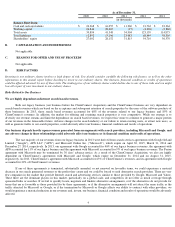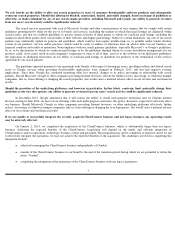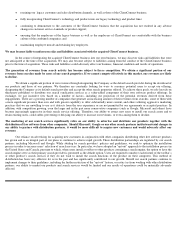Incredimail 2013 Annual Report Download - page 18
Download and view the complete annual report
Please find page 18 of the 2013 Incredimail annual report below. You can navigate through the pages in the report by either clicking on the pages listed below, or by using the keyword search tool below to find specific information within the annual report.
Additionally, no assurances can be given that any of the patent applications that we have filed will result in a patent being issued, or that
any existing or future patents will afford adequate protection against competitors and similar technologies.
We use certain “open source”
software tools that may be subject to intellectual property infringement claims or that may subject our
derivative products to unintended consequences, possibly impairing our product development plans, interfering with our ability to
support our clients or requiring us to allow access to our products or necessitating that we pay licensing fees.
Certain of our software products contain a limited amount of open source code and we may use more open source code in the future. In
addition, certain third party software that we embed in our products contains open source code. Open source code is code that is covered by a
license agreement that permits the user to liberally use, copy, modify and distribute the software without cost, provided that users and modifiers
abide by certain licensing requirements. The original developers of the open source code provide no warranties on such code.
As a result of our use of open source software, we could be subject to suits by parties claiming ownership of what we believe to be open
source code and we may incur expenses in defending claims that we did not abide by the open source code license. In addition, third party
licensors do not provide intellectual property protection with respect to the open source components of their products, and we may be unable to
be indemnified by such third party licensors in the event that we or our customers will be held liable in respect of the open source software
contained in such third party software. If we are not successful in defending against any such claims that may arise, we may be subject to
injunctions and/or monetary damages or be required to remove the open source code from our products. Such events could disrupt our
operations and the sales of our products, which would negatively impact our revenues and cash flow.
Moreover, under certain conditions, the use of open source code to create derivative code may obligate us to make the resulting
derivative code available to others at no cost. The circumstances under which our use of open source code would compel us to offer derivative
code at no cost are subject to varying interpretations. If we are required to publicly disclose the source code for such derivative products or to
license our derivative products that use an open source license, our previously proprietary software products may be available to others without
charge. If this happens, our customers and our competitors may have access to our products without cost to them, which could harm our
business.
We monitor our use of such open source code to avoid subjecting our products to conditions we do not intend. The use of such open
source code, however, may ultimately subject some of our products to unintended conditions so that we are required to take remedial action that
may divert resources away from our development efforts.
If we fail to detect and stop misrepresentations of our site and products, are unsuccessful in preventing and combating the onset of
malicious applications in our products, or for some reason are perceived as promoting malware or "spamming" or unjustly changing
the user’
s computer settings, we could lose the confidence of the users of our products and services, or our software or provision of
search services or advertising could be blocked by software or utilities designed to detect such practices, thereby causing our business to
suffer.
We are exposed to the risk of domains using our brand names (such as "CodeFuel" "ClientConnect", "IncrediMail", "Molto",
"PhotoJoy", "Smilebox", "SweetIM", etc.) in various ways, and attracting in this manner our potential or existing users. These domains often
engage in fraudulent or spam activities and their use of our brand names can result in damage to our reputation and loss of our clients' confidence
in our products. In addition, downloadable applications through which a toolbar may be installed by an end-
user are also subject to attack by
viruses, worms and other malicious software programs, which could jeopardize the security of information stored in users' computers or in our
systems and networks. Additionally, search websites to which end users may be directed may be adversely affected by such attacks resulting in
changes to users' computers and interference with the overall experience of our products and services, such as the hijacking of queries to these
websites or the modification or replacement of search results generated. No assurances can be given that our efforts to combat these malicious
applications will be successful and/or that our products and services will not have (or will not be perceived to have) vulnerabilities in this regard.
Furthermore, if we or our products were for some reason perceived as promoting or as being "malware or "spamming", or unjustly changing the
user’
s computer settings, our software or provision of search services or advertising could be blocked by software or utilities designed to detect
such practices. If we are unable to effectively detect and terminate this misrepresentation activity of others or the way that we and our products
are perceived, we may lose users and our ability to produce revenues will be harmed.
14
























